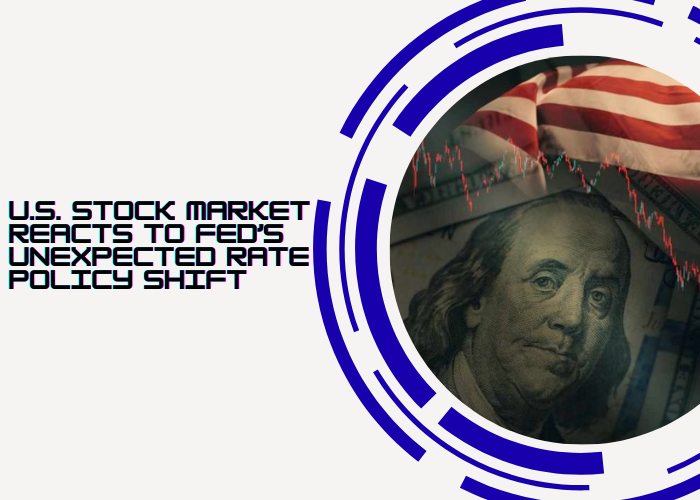U.S. Stock Market Reacts to Fed’s Unexpected Rate Policy Shift
The U.S. financial market experienced significant volatility this week following the Federal Reserve’s unexpected announcement regarding interest rates. Investors were taken aback when the Fed signaled a more aggressive approach to controlling inflation than previously anticipated. This policy shift has tThe U.S. financial markets entered a period of heightened turbulence this week after the Federal Reserve surprised investors with an unexpected policy announcement regarding interest rates. What began as cautious optimism in early sessions quickly turned into broad uncertainty as the Fed signaled a more aggressive approach to combating inflation than markets had priced in. This announcement had an immediate ripple effect across Wall Street, triggering declines in major indices such as the S&P 500 and sparking sharp intraday swings in the technology-heavy Nasdaq. For investors, the week underscored just how deeply interconnected monetary policy, global capital flows, and individual market sectors have become.
Immediate Impact on Stock Indices
The Fed’s shift in tone created immediate shockwaves in U.S. equity markets. The S&P 500, which had been trading near resistance levels, saw a sharp dip as traders digested the announcement. The Nasdaq, already vulnerable due to its heavy weighting in high-growth technology companies, experienced significant intraday volatility. Market sentiment quickly turned defensive as participants reassessed how rising borrowing costs could affect corporate earnings, valuations, and overall growth expectations. Historically, sudden monetary policy adjustments prompt rapid portfolio reshuffling, and this week was no exception.
Investors rotated away from growth and momentum stocks and sought safety in defensive sectors such as healthcare, consumer staples, and utilities. Large-cap tech names, which had driven much of the market’s performance in recent years, became the focal point of selling pressure, while traditional defensive plays saw renewed demand. The speed of these adjustments highlighted how quickly sentiment can pivot when monetary conditions change unexpectedly.
Bond Market and Interest Rate Dynamics
In the bond market, yields on U.S. Treasury securities spiked as traders recalibrated their expectations for the path of interest rates. Short-term yields rose sharply, reflecting anticipation of additional hikes in the months ahead, while long-term yields also moved higher but at a slower pace, contributing to an increasingly flat yield curve. This dynamic often signals investor caution about future economic growth, as tighter monetary policy raises the cost of borrowing for households and businesses alike.
Rising yields have direct implications for mortgage markets, auto loans, and corporate financing. As the cost of capital climbs, heavily indebted companies face higher refinancing costs, and households encounter more expensive borrowing terms. For the housing sector in particular, higher mortgage rates can quickly dampen demand, slowing both new construction and home sales. Meanwhile, companies that had relied on low-interest debt to fuel expansion may be forced to scale back growth initiatives or prioritize deleveraging strategies.
Sector and Corporate Reactions
The policy shift also placed a spotlight on specific sectors. Companies with robust balance sheets and consistent cash flow are better equipped to weather tightening financial conditions, while highly leveraged businesses may struggle to adapt. Technology and consumer discretionary stocks, both of which rely heavily on investor confidence in future growth, became particularly vulnerable to valuation compression. Real estate investment trusts (REITs) also faced pressure as higher yields reduced the relative attractiveness of dividend payouts.
By contrast, sectors tied to essential goods and services displayed resilience. Healthcare companies, for instance, maintained stability thanks to steady demand regardless of macroeconomic conditions. Energy stocks also drew investor attention, especially as commodity markets responded to currency movements and global supply considerations. These divergences underline the importance of active sector allocation when navigating volatile environments.
Currency and Commodity Markets
Currency markets reacted swiftly, with the U.S. dollar strengthening against major counterparts. A stronger dollar benefits importers but challenges exporters by making U.S. goods less competitive abroad. This dynamic complicates earnings outlooks for multinational corporations, particularly those generating significant revenue overseas. Emerging market currencies also came under pressure as investors redirected capital toward higher-yielding U.S. assets.
Commodities adjusted to the shifting landscape. Gold, typically seen as a hedge during uncertain times, saw price fluctuations as higher interest rates increased the opportunity cost of holding non-yielding assets. Oil markets responded both to currency strength and broader global demand considerations, while agricultural products remained sensitive to shifting trade flows and geopolitical dynamics. The interplay between monetary policy and commodities reinforced the interconnected nature of modern markets.
Investment Strategies in Volatile Conditions
Advisors emphasized the importance of diversification in navigating turbulent markets. Investors were encouraged to reassess portfolio allocations, focusing on companies with strong fundamentals, reliable earnings, and manageable debt levels. Defensive equity positions combined with exposure to bonds, commodities, and alternative assets can provide buffers against volatility. At the same time, opportunities may arise in oversold sectors where valuations have reset, creating potential entry points for long-term investors.
Short-term traders, meanwhile, were advised to remain nimble and attentive to macroeconomic data releases that could influence policy expectations. The ability to pivot quickly in response to new information became a valuable skill during a week characterized by rapid market swings and shifting sentiment.
Long-Term Considerations
While short-term volatility can be uncomfortable, long-term strategies remain anchored in discipline and diversification. Historical patterns suggest that markets often adjust to new monetary policy regimes over time, rewarding patient investors who avoid overreacting to daily fluctuations. Engaging with financial advisors, conducting thorough research, and maintaining a long-term perspective help investors withstand turbulence while remaining positioned for recovery and growth once stability returns.
Global Ripple Effects
Beyond U.S. borders, international markets absorbed the shock of the Fed’s announcement. Emerging markets, in particular, faced risks of capital outflows as investors sought higher yields in dollar-denominated assets. Multinational corporations were tasked with managing currency risks and adjusting supply chain strategies in response to shifting cost structures. Global economic interconnectivity ensured that a policy adjustment in Washington reverberated from Asia to Europe and Latin America.
For policymakers abroad, the Fed’s stance also posed challenges. Central banks in other economies must weigh their own inflation and growth dynamics while considering how divergent monetary paths could influence exchange rates, capital flows, and competitiveness in global markets. The situation underscored the delicate balance required in today’s interconnected financial system.
Monitoring Key Indicators
Looking ahead, investors will closely monitor upcoming reports on employment, consumer spending, and manufacturing output. These data points will play a central role in shaping expectations for the Fed’s next moves and could either reinforce or challenge current market narratives. Staying informed and adaptable remains essential for navigating the ongoing uncertainty.
Conclusion
The U.S. financial markets are moving through a complex environment shaped by monetary policy surprises, inflationary pressures, and global economic interdependencies. While volatility is likely to persist, investors who remain disciplined, diversified, and proactive are best positioned to safeguard capital and seize opportunities. The events of this week serve as a reminder that agility and informed decision-making are invaluable assets in an ever-changing financial landscape.



